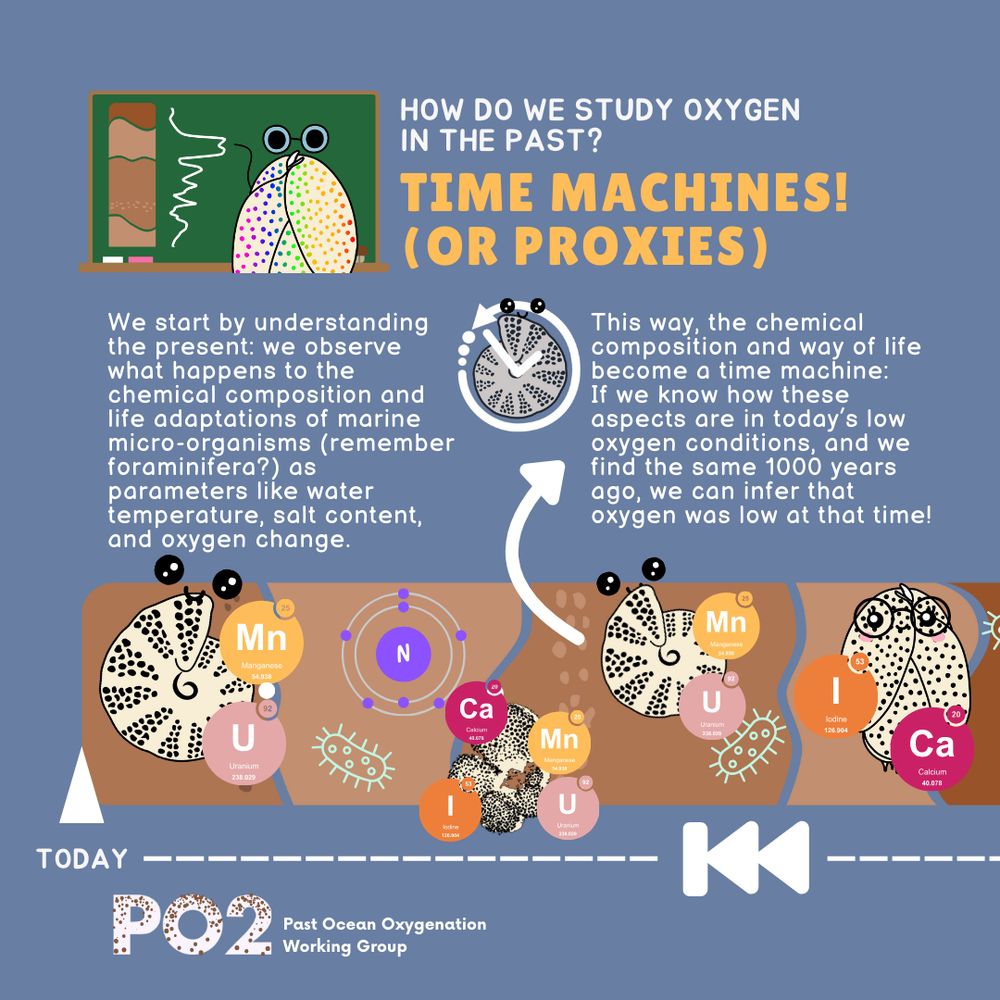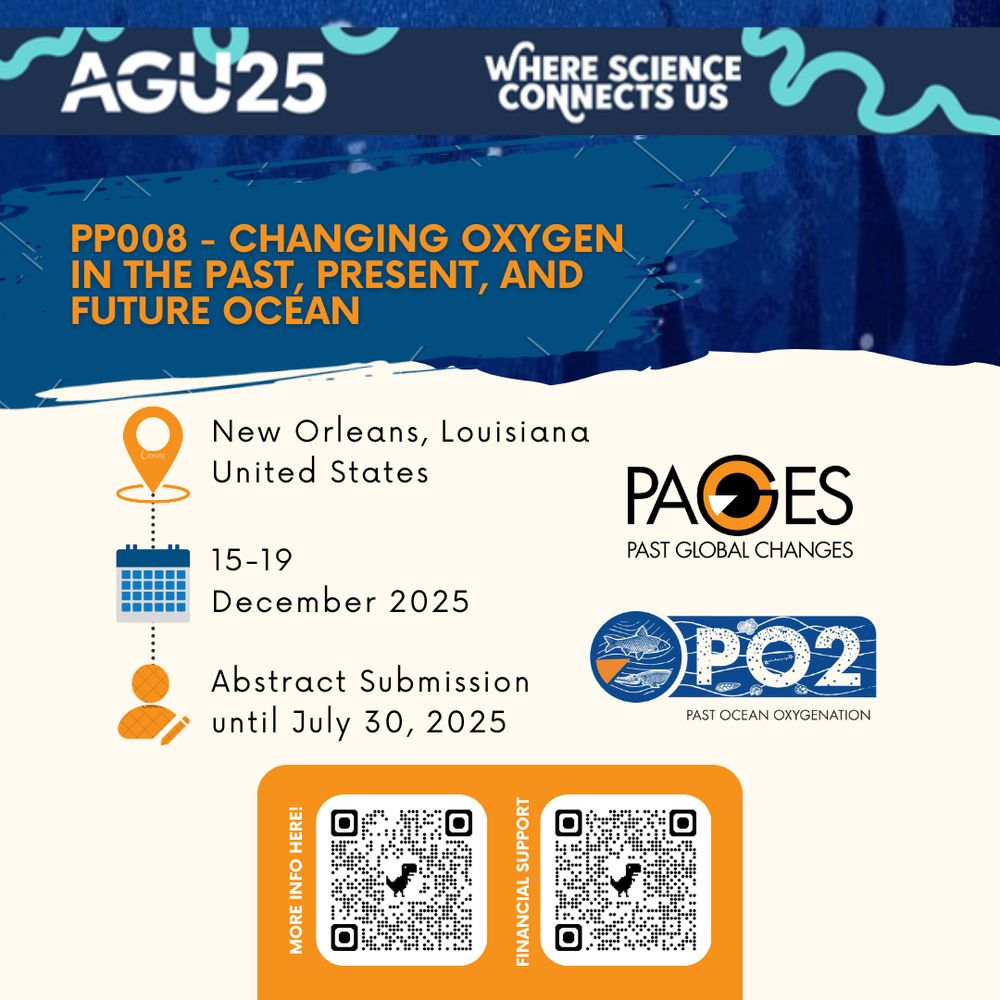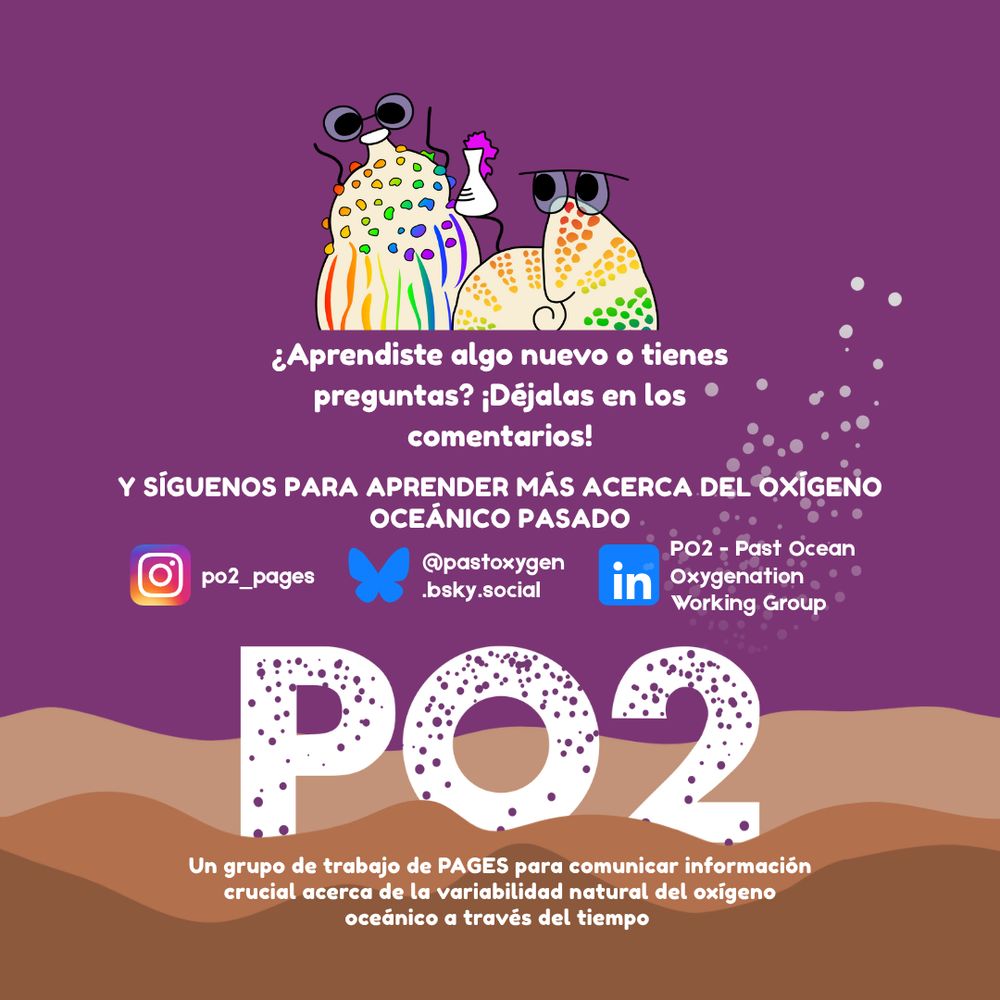
PO2 - Past Ocean Oxygen Working Group
@pastoxygen.bsky.social
The working group’s scientific goal is to provide crucial insights into the natural variability of seawater dissolved oxygen concentrations during key time periods in the geological record.
The theme of the #UNESCO celebration for this year is Trust, Transformation, and Tomorrow: The Science We Need for 2050. We deserve a world at peace, and science is the key to making it happen! Would you join the change?

November 10, 2025 at 9:47 PM
The theme of the #UNESCO celebration for this year is Trust, Transformation, and Tomorrow: The Science We Need for 2050. We deserve a world at peace, and science is the key to making it happen! Would you join the change?
Today’s a special day. it’s World Science Day for Peace and Development! 🌍✨It’s all about boosting public awareness, sharing knowledge, and teaming up across borders. Because when nations unite through science, we get closer to figuring out how to live in a peaceful, sustainable world, together! 🔬🤝💚


November 10, 2025 at 9:47 PM
Today’s a special day. it’s World Science Day for Peace and Development! 🌍✨It’s all about boosting public awareness, sharing knowledge, and teaming up across borders. Because when nations unite through science, we get closer to figuring out how to live in a peaceful, sustainable world, together! 🔬🤝💚
In summary, we infer that a weak AMOC-driven heat transport decrease led to a strong temperature gradient between the tropical & NAtlantic, that accelerated subsurface circulation, bringing more oxygen to the OMZ we studied. Did you learn something new? Follow us and share! 🌊🐚🔬🤔

November 4, 2025 at 2:19 PM
In summary, we infer that a weak AMOC-driven heat transport decrease led to a strong temperature gradient between the tropical & NAtlantic, that accelerated subsurface circulation, bringing more oxygen to the OMZ we studied. Did you learn something new? Follow us and share! 🌊🐚🔬🤔
Findings: with a slow AMOC there was + oxygen, suggesting a stronger subsurface circulation that brought + oxygen to the OMZ🧐Since winds' strength depends on temperature & air pressure, we calculated the sea surface temperature diff. between tropical & NAtlantic: they were larger with a slow AMOC 😱

November 4, 2025 at 2:19 PM
Findings: with a slow AMOC there was + oxygen, suggesting a stronger subsurface circulation that brought + oxygen to the OMZ🧐Since winds' strength depends on temperature & air pressure, we calculated the sea surface temperature diff. between tropical & NAtlantic: they were larger with a slow AMOC 😱
AMOC slowed 2 times in the last 27k years, and to understand what happens to subsurface circulation with this slowdown, the authors reconstructed oxygen changes using benthic forams distribution in the OMZ off the Senegal coast.

November 4, 2025 at 2:19 PM
AMOC slowed 2 times in the last 27k years, and to understand what happens to subsurface circulation with this slowdown, the authors reconstructed oxygen changes using benthic forams distribution in the OMZ off the Senegal coast.
In the deep ocean, density differences drive thermohaline circulation as ocean layers have different temperature & salt content. In the shallower ocean, winds also drive circulation & supply oxygen! Today, areas with little oxygen (Oxygen Minimum Zones-OMZ) form where subsurface circulation is slow

November 4, 2025 at 2:19 PM
In the deep ocean, density differences drive thermohaline circulation as ocean layers have different temperature & salt content. In the shallower ocean, winds also drive circulation & supply oxygen! Today, areas with little oxygen (Oxygen Minimum Zones-OMZ) form where subsurface circulation is slow
Agglutinated forams (forams that make their shells by adding or agglutinating sorrounding stuff) make their shells by gluing things they find around them: sand, minerals, and skeletons of other organisms! This includes other forams, sponge spicules, even radiolaria! 😱😱
November 1, 2025 at 10:57 AM
Agglutinated forams (forams that make their shells by adding or agglutinating sorrounding stuff) make their shells by gluing things they find around them: sand, minerals, and skeletons of other organisms! This includes other forams, sponge spicules, even radiolaria! 😱😱
Forams are super cute, but some of them are just spooky 🎃Did you know some forams make their shells gluing “skeletons” of other fossils?
November 1, 2025 at 10:57 AM
Forams are super cute, but some of them are just spooky 🎃Did you know some forams make their shells gluing “skeletons” of other fossils?
📣Don’t miss out! You can still register for the PO2 Second Workshop!🌊 We invite the #ocean#oxygen community to our #PO2workshop. Announced Past Global Changes, Past Ocean Oxygenation and NC Museum of Natural Sciences.
Scan the QR for details on our #registration. @pages-ecn.bsky.social
Scan the QR for details on our #registration. @pages-ecn.bsky.social

September 26, 2025 at 1:27 PM
📣Don’t miss out! You can still register for the PO2 Second Workshop!🌊 We invite the #ocean#oxygen community to our #PO2workshop. Announced Past Global Changes, Past Ocean Oxygenation and NC Museum of Natural Sciences.
Scan the QR for details on our #registration. @pages-ecn.bsky.social
Scan the QR for details on our #registration. @pages-ecn.bsky.social
Pretty cool, right? Can you think of other shell features or clues that could serve as proxies? Share your ideas in the comments!
Post by @sofigerina.bsky.social @dharmarx.bsky.social sebastiangarrido
#pastoceanoxygenation #scicomm #paleoclimate #proxies #foraminifera #timemachines
Post by @sofigerina.bsky.social @dharmarx.bsky.social sebastiangarrido
#pastoceanoxygenation #scicomm #paleoclimate #proxies #foraminifera #timemachines

August 29, 2025 at 11:12 AM
Pretty cool, right? Can you think of other shell features or clues that could serve as proxies? Share your ideas in the comments!
Post by @sofigerina.bsky.social @dharmarx.bsky.social sebastiangarrido
#pastoceanoxygenation #scicomm #paleoclimate #proxies #foraminifera #timemachines
Post by @sofigerina.bsky.social @dharmarx.bsky.social sebastiangarrido
#pastoceanoxygenation #scicomm #paleoclimate #proxies #foraminifera #timemachines
Hi again, Oxyguys!!🤓🌍🌊“Proxies: Windows into the Past” Did you know scientists can uncover past climates using proxies? These are measurable clues preserved in marine sediments—like tiny “time machines” recording signals of temperature, oxygen, or salt. @pages-ipo.bsky.social @pages-ecn.bsky.social


August 29, 2025 at 11:12 AM
Hi again, Oxyguys!!🤓🌍🌊“Proxies: Windows into the Past” Did you know scientists can uncover past climates using proxies? These are measurable clues preserved in marine sediments—like tiny “time machines” recording signals of temperature, oxygen, or salt. @pages-ipo.bsky.social @pages-ecn.bsky.social
Estos hallazgos podrían cambiar lo que sabemos sobre la vida marina y cómo el océano abisal se mantiene oxigenado. Impresionante, ¿verdad?

August 14, 2025 at 2:53 PM
Estos hallazgos podrían cambiar lo que sabemos sobre la vida marina y cómo el océano abisal se mantiene oxigenado. Impresionante, ¿verdad?
El estudio se hizo en una zona cubierta de nódulos polimetálicos, por lo que los autores plantean que el alto voltaje de los nódulos dio lugar a la electrólisis, un proceso por el cual se descomponen las moléculas de agua en oxígeno e hidrógeno.

August 14, 2025 at 2:53 PM
El estudio se hizo en una zona cubierta de nódulos polimetálicos, por lo que los autores plantean que el alto voltaje de los nódulos dio lugar a la electrólisis, un proceso por el cual se descomponen las moléculas de agua en oxígeno e hidrógeno.
Investigadores instalaron cámaras bentónicas en el fondo marino abisal del Océano Pacífico para cuantificar el oxígeno en un periodo de tiempo y ¡los datos muestran más oxígeno del esperado! lo que sugiere que en las profundidades del océano también se produce O₂

August 14, 2025 at 2:53 PM
Investigadores instalaron cámaras bentónicas en el fondo marino abisal del Océano Pacífico para cuantificar el oxígeno en un periodo de tiempo y ¡los datos muestran más oxígeno del esperado! lo que sugiere que en las profundidades del océano también se produce O₂
📑🔬¿Sabes qué es el oxígeno oscuro? Un estudio publicado en Nature Geoscience muestra un descubrimiento sorprendente: más oxígeno del esperado en el océano profundo. Aquí, el oxígeno proviene de la ventilación de aguas menos profundas y es consumido por organismos para respirar y oxidar materia.

August 14, 2025 at 2:53 PM
📑🔬¿Sabes qué es el oxígeno oscuro? Un estudio publicado en Nature Geoscience muestra un descubrimiento sorprendente: más oxígeno del esperado en el océano profundo. Aquí, el oxígeno proviene de la ventilación de aguas menos profundas y es consumido por organismos para respirar y oxidar materia.
Impressive right? If you learned something new or have other questions leave it in the comments, we will do our best to reply. This is a post Maria Yolanda Nuñez (Illustration and texts) and @sofigerina.bsky.social (text and edits).

August 12, 2025 at 3:41 PM
Impressive right? If you learned something new or have other questions leave it in the comments, we will do our best to reply. This is a post Maria Yolanda Nuñez (Illustration and texts) and @sofigerina.bsky.social (text and edits).
Since the chambers were located in a polymetallic nodule-covered zone. Their hypothesis: high voltage of nodules enabled electrolysis to break down water molecules into oxygen & hydrogen. The findings could change what we know about ocean life, chemistry & how the abyssal ocean remains oxygenated.

August 12, 2025 at 3:41 PM
Since the chambers were located in a polymetallic nodule-covered zone. Their hypothesis: high voltage of nodules enabled electrolysis to break down water molecules into oxygen & hydrogen. The findings could change what we know about ocean life, chemistry & how the abyssal ocean remains oxygenated.
The researchers installed benthic chambers in the Pacific Ocean abyssal seafloor to quantify oxygen over a period of time. The data shows more oxygen than expected, suggesting additional O2 was being produced!

August 12, 2025 at 3:41 PM
The researchers installed benthic chambers in the Pacific Ocean abyssal seafloor to quantify oxygen over a period of time. The data shows more oxygen than expected, suggesting additional O2 was being produced!
📑🔬You asked about dark oxygen, here it is! In Nature Geosciences, a study shows a striking discovery: more oxygen than expected in the abyssal ocean. Here, oxygen is mostly supplied by ventilation from shallower waters, & it is consumed by organisms through respiration and oxidation of matter.

August 12, 2025 at 3:41 PM
📑🔬You asked about dark oxygen, here it is! In Nature Geosciences, a study shows a striking discovery: more oxygen than expected in the abyssal ocean. Here, oxygen is mostly supplied by ventilation from shallower waters, & it is consumed by organisms through respiration and oxidation of matter.
📣 Abstract submission is open for the Ocean Science Meeting!🌊We invite the #ocean #oxygen community to our PO2 session on #past, #present, & #future #deoxygenation. Join us at the conference. 👉 Scan the QR for details on our session and travel #funding options.@pages-ipo.bsky.social @agu.org #OSM26

August 8, 2025 at 2:42 PM
📣Exciting Announcement: PO2 Newsletter – 5th Edition is out! 🔬 🌊 🌏
We’re happy to share the new edition of the Past Ocean Oxygenation (PO2) Newsletter! This issue features updates on major events and recent research related to ocean oxygenation in the past. @pages-ipo.bsky.social
We’re happy to share the new edition of the Past Ocean Oxygenation (PO2) Newsletter! This issue features updates on major events and recent research related to ocean oxygenation in the past. @pages-ipo.bsky.social
August 5, 2025 at 9:36 AM
📣Exciting Announcement: PO2 Newsletter – 5th Edition is out! 🔬 🌊 🌏
We’re happy to share the new edition of the Past Ocean Oxygenation (PO2) Newsletter! This issue features updates on major events and recent research related to ocean oxygenation in the past. @pages-ipo.bsky.social
We’re happy to share the new edition of the Past Ocean Oxygenation (PO2) Newsletter! This issue features updates on major events and recent research related to ocean oxygenation in the past. @pages-ipo.bsky.social
Hi 🤓🌊🌍ocean oxygen community. 💡📑Abstract submission is now open for the American Geoscience Meeting - AGU @agu.org. We want to invite you to join our PO2 session about past, present and future deoxygenation. In the following QR you will find information about our session and travel funding options.

July 15, 2025 at 2:13 PM
Hi 🤓🌊🌍ocean oxygen community. 💡📑Abstract submission is now open for the American Geoscience Meeting - AGU @agu.org. We want to invite you to join our PO2 session about past, present and future deoxygenation. In the following QR you will find information about our session and travel funding options.
🤔⁉️📝Si aprendiste algo nuevo o tienes preguntas acerca de los forams déjalas en los comentarios. Síguenos si quieres aprender más de los foraminíferos y lo que nos puede decir acerca del oxígeno oceánico pasado.🐚
#micropaleontologia #foraminiferos #bentonicos #planctônicos #paleoclima #paleoambiente
#micropaleontologia #foraminiferos #bentonicos #planctônicos #paleoclima #paleoambiente

July 4, 2025 at 9:57 AM
🤔⁉️📝Si aprendiste algo nuevo o tienes preguntas acerca de los forams déjalas en los comentarios. Síguenos si quieres aprender más de los foraminíferos y lo que nos puede decir acerca del oxígeno oceánico pasado.🐚
#micropaleontologia #foraminiferos #bentonicos #planctônicos #paleoclima #paleoambiente
#micropaleontologia #foraminiferos #bentonicos #planctônicos #paleoclima #paleoambiente


